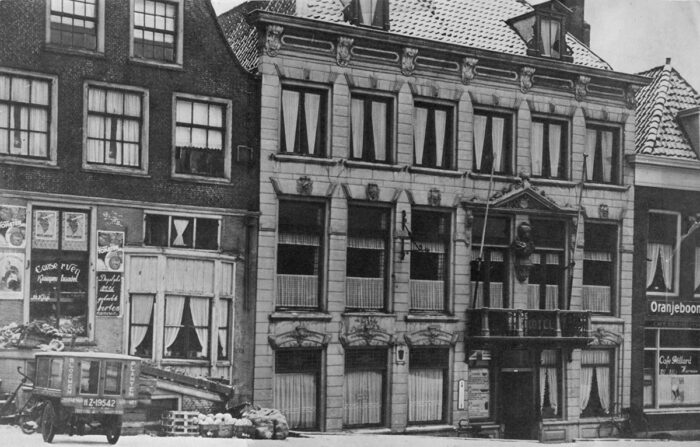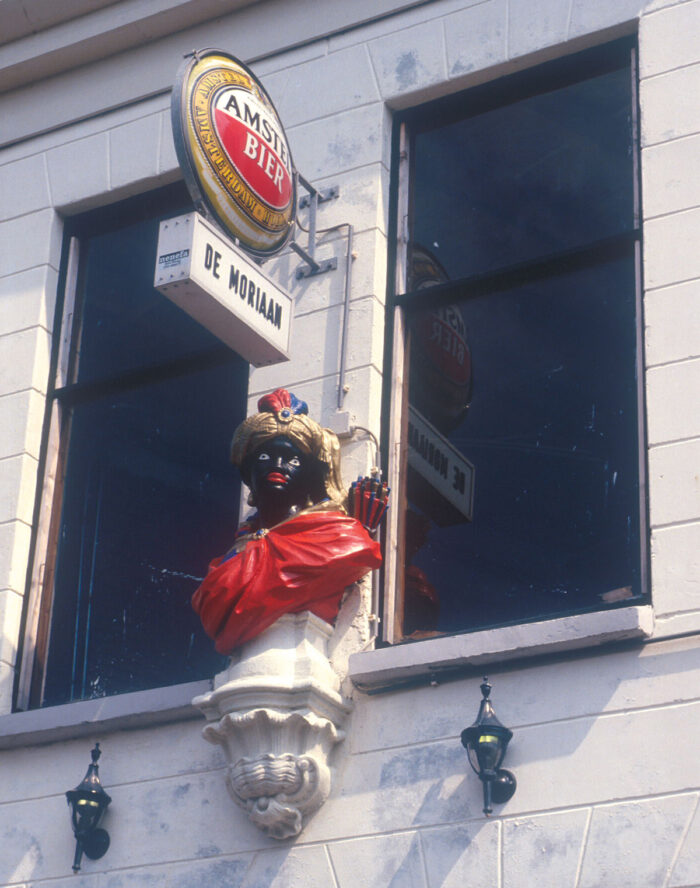
De oude herberg De Moriaan
The former inn The Moriaan

De Moriaan hierboven aan de gevel
The Morian at the façade above
Een Moriaan is een beeltenis. Soms een borstbeeld, zoals hier in Maassluis, maar er zijn ook wel Morianen uitgebeeld van hoofd tot voeten. Altijd is het een man met een donker uiterlijk en altijd ‘Arabisch’ gekleed, kleurig, met een tulband en wijde kleren. Niet West-Europees dus. En daar ging het om. Een Moriaan was het beeldmerk voor een mens uit verre landen, van vreemde kusten. Als Herberg De Moriaan vandaag geopend werd zou het waarschijnlijk Hotel International heten. Dat was waar de exotische Moriaan op doelde.
In voorbije eeuwen konden de meeste mensen niet lezen. Straatnaamborden en huisnummers waren er nog niet. Dan was een beeltenis op de gevel het middel om te vertellen over het wat, hoe en wie van een gebouw. Herberg De Moriaan stond aan de Haven. Het was een logeerplaats voor passanten die overstapten van de trekschuiten uit Delft en Den Haag op de veerboot over de Maas, maar ook voor schepelingen van de handelsvloot.
In alle oude steden vinden we beeldmerken aan oude gevels. Maar wacht even… doen wij niet precies hetzelfde? Elk bedrijf heeft toch zijn eigen beeldmerk, zijn logo? Wij gebruiken ze nog steeds, en meer dan ooit tevoren! U kent toch het logo van Shell, de MacDonalds, een arts, de politie?
Het woord Moriaan komt voor in de talen van alle West-Europese kustvolken: morian (Scandinavië, Engels, Spaans), murjaani (Fins), mouriâne, morien (Frans). Ook de Romeinen kenden het woord al: Mauritânus (Latijn). In dit aloude woord herkennen we meteen de letterlijke betekenis: bewoner van Mauritanië. Daarmee werd niet het huidige land aan de westkust van Afrika bedoeld, maar het oude koninkrijk Mauritanië, het land van de Mauri (‘Moren’), dat zich uitstrekte over een groot deel van Noord-Afrika, van Marokko tot aan de Nijl toe.
De naam Moriaan is in Nederland al voor 1200 in gebruik. Het oudste bakstenen huis in ’s Hertogenbosch (vermoedelijk ook het oudste bakstenen huis van Nederland) heet De Moriaan. De kroniekschrijver Cuperinus beschrijft in de eerste helft 16e eeuw dat het omstreeks 1174 werd gebouwd: ‘In die tijd liet de hertog van Brabant Hendrik I op de Markt twee mooie huizen bouwen, “te weten Roijenburgh ende tcasteel op die Moriaen”.’
Kijk nog even naar de kleding van de Moriaan, wijd en luchtig, het hoofd bedekt met een tulband. Een zwierig geplooide luchtlaag om hoofd en lijf koel te houden onder de brandende zon. Mooi en slim tegelijk!
++++++++++++++++++++
A MORIAN AS LOGO
A Morian is an image. Sometimes a bust, as here in Maassluis, but there are also Morians depicted from head to feet. It is always a man with a dark appearance and always “Arabic” dressed, colorful, with a turban and wide clothes. Not Western European. And that’s what it was about. A Morian was the symbol for a person from distant lands, from foreign shores. If Herberg De Moriaan opened today, it would probably be called Hotel International. That was what the exotic Morian was referring to.
In centuries past, most people could not read. There were no street signs and house numbers yet. Then an image on the facade was the means to tell about the what, how and who of a building. Herberg De Moriaan was located at the Haven (harbour). It was a place to stay for passers-by who transferred from the barges from Delft and The Hague to the ferry across the river Maas, but also for sailors from the merchant fleet.
In all old towns we find images on old facades. But wait a minute… aren’t we doing the exact same thing today? Every company has its own logo, as a brand, right? So we still use them, and more than ever before! You do know the logos of a Mercedes, MacDonalds, a doctor, the police?
The word Morian occurs in the languages of all Western European coastal peoples: morian (Scandinavian, English, Spanish), murjaani (Finnish), mouriâne, morien (French). The Romans already knew the word: Mauritânus (Latin). In this ancient word we immediately recognize the literal meaning: inhabitant of Mauritania. This did not mean the present country on the west coast of Africa, but the ancient kingdom of Mauritania, the land of the Mauri (“Moors”), which stretched over much of North Africa, from Morocco to the Nile. (Recognize the Mor in Morocco?).
The name Morian has been in use in the Netherlands since 1200. The oldest brick house in the city of ’s Hertogenbosch (probably also the oldest brick house in the Netherlands) is called De Moriaan. The chronicler Cuperinus describes in the first half of the 16th century that it was built around 1174: ‘At that time, the Duke of Brabant Henry the First had two beautiful houses built on the Markt, ‘namely Roijenburgh andde the castle of the Moriaen’.’
Take another look at the Morian’s clothing, wide and airy, the head covered with a turban. A gracefully pleated layer of air to keep head and body cool under the blazing sun. Beautiful and smart at the same time!

De oude herberg De Moriaan
The former inn The Moriaan

De Moriaan hierboven aan de gevel
The Morian at the façade above